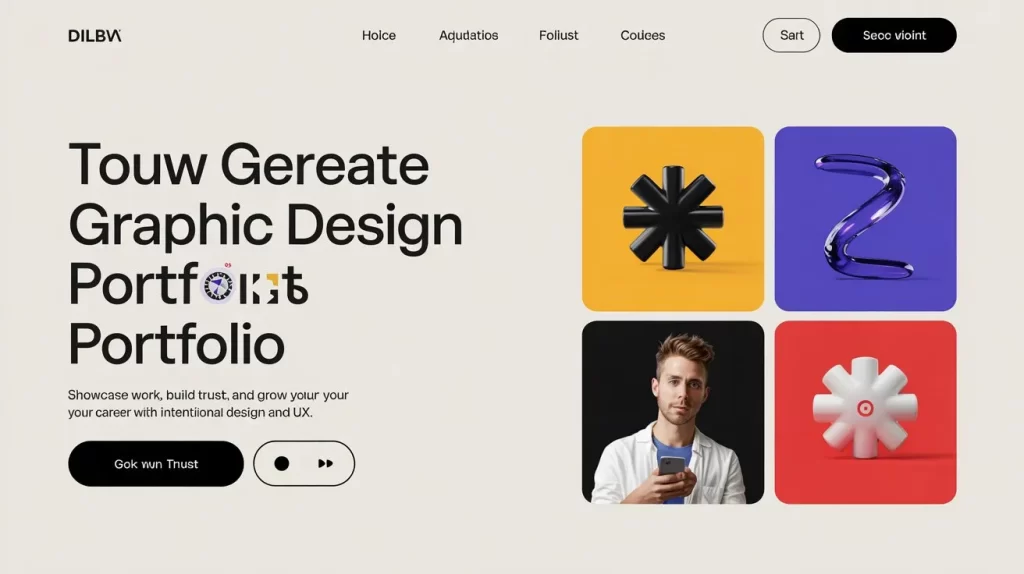It’s More Than a Website It’s Your Sales Rep
In today’s freelance economy, a resume is rarely enough. And social profiles only get you so far. Whether you’re a designer, creative technologist, or agency builder your graphic design portfolio website is the most powerful tool in your career arsenal.
It works while you sleep. It qualifies leads, builds credibility, tells your story, and if done right converts casual browsers into booked clients.
I’ve worked with dozens of freelancers who struggled with visibility until their portfolio site became strategic. Let’s break down exactly why this matters and how to make yours work like a growth engine, not a digital brochure.
Suggested Posts:
• Technical SEO Audits
• What is SEO Site Audit?
• Recover from Google Penalties

What a Portfolio Website Really Does
A well-designed portfolio website graphic design isn’t just a collection of work. It does four crucial things at once:
- Demonstrates expertise through visuals and layout hierarchy
- Communicates professionalism and brand tone
- Guides visitors to action with intuitive user experience (UX)
- Creates trust and differentiation in a saturated market
Great design doesn’t just look good. It performs.
Career Growth Starts with Visibility
Your work might be amazing. But if no one sees it, it doesn’t matter.
A personal website for graphic designer professionals acts as a central hub—one that search engines, clients, agencies, and recruiters can find, explore, and engage with.
Your name becomes searchable. Your domain becomes your brand. Your UX becomes your first impression.
When I was reviewing portfolios for a creative agency role in Chicago, I saw 50+ Behance and Dribbble profiles. The one candidate with a personal site that explained their thought process? Hired in under a week.

Why Clients Choose You Based on Your Website
People hire people they trust. Your portfolio builds that trust by:
- Showing process, not just deliverables
- Highlighting real-world outcomes (“increased conversions by 22%”)
- Matching your visual consistency to their brand sensibility
- Making contact frictionless (clear CTA, mobile-friendly, fast load)
The best graphic designer websites aren’t flashy—they’re focused. A client should land, scroll, and say: “Yes, this person gets it.”
Suggested Posts:
• Ecommerce SEO Audit
• E-Commerce SEO Audit
• Optimize Ecommerce Voice Search
What Makes a Portfolio Site Convert
Strategic UX
Every click, scroll, and transition should feel purposeful. Your layout hierarchy should guide the visitor from intro → work samples → context → call-to-action.
Use white space. Break visual monotony. Make navigation obvious. And for the love of design make it mobile-first.
Case-Study-Driven Content
A static image gallery is forgettable. A case study that walks me through your thinking? That’s memorable.
Each project should show:
- The challenge
- The approach
- The solution
- The result
Even a few sentences of narrative per project builds trust like no carousel ever could.
Visual Consistency = Brand Identity
Your website is your brand system. Fonts, color palettes, spacing, and interaction patterns should mirror the type of client you want to attract.
Minimalist? Own it. Vibrant and animated? Go all in. Just don’t mix vibes. A scattered identity repels confident decision-making.
Portfolio Sites for Freelancers vs. Agencies
Freelancers should focus on clarity and personality human stories, sharp visuals, and one clear CTA (usually “Book a Call” or “Get in Touch”).
Agencies, however, need to elevate trust signals think testimonials, process diagrams, team bios, and conversion-oriented landing pages.
Both should make it crystal clear what problems they solve and for whom.
How a Portfolio Site Impacts Client Acquisition
A strong portfolio site:
- Attracts inbound leads via SEO
- Lets you skip the “what do you do?” calls
- Filters out bad-fit clients
- Shortens your sales cycle
- Positions you as a premium provider
A weak one? It loses you the lead before they ever reach out.
I’ve seen it happen. A designer with killer work had zero leads. Why? No CTA, slow site speed, confusing navigation, and no mobile view. We rebuilt her site with clear UX and narrative—she landed 3 new clients in a month.
Real Examples – Portfolio Sites That Convert
- Jessica Hische — Branding and typography with personality, clarity, and direct service offerings
- Studio Feixen — Motion, case studies, and a tight brand system that screams capability
- Malika Favre — Minimal, bold, and unmistakably hers
These are not just sites. They are brand statements—and conversion machines.
Key Takeaways
Your graphic design portfolio website is no longer optional. It’s the front door to your creative career and your first sales conversation. Done well, it builds your authority, filters your audience, and creates alignment between you and the clients you actually want to work with.
If you don’t have one yet, now is the time. And if you do? Make sure it’s not just showcasing what you’ve done but why it matters.
- A portfolio site is your most important career asset
- UX, visual consistency, and storytelling convert better than galleries
- Your site must reflect your brand tone and your audience’s needs
- Treat your portfolio as a sales tool, not a trophy case
- Great work doesn’t get you hired—visible, thoughtful work does
FAQs
Is a portfolio site better than Behance or Dribble?
Yes. Those platforms are crowded and lack context. A personal site puts you in control of the narrative and shows you’re serious.
How many projects should I include?
5–7 strong case studies are plenty. Focus on quality, not quantity.
What platform should I build on?
Webflow and WordPress offer flexibility. Squarespace and Wix are faster to launch. Choose what lets you best reflect your UX strengths.
Do I need SEO for my portfolio?
Yes, especially for niche terms like “freelance UX designer in NYC.” Even basic optimization can drive real inbound opportunities.
